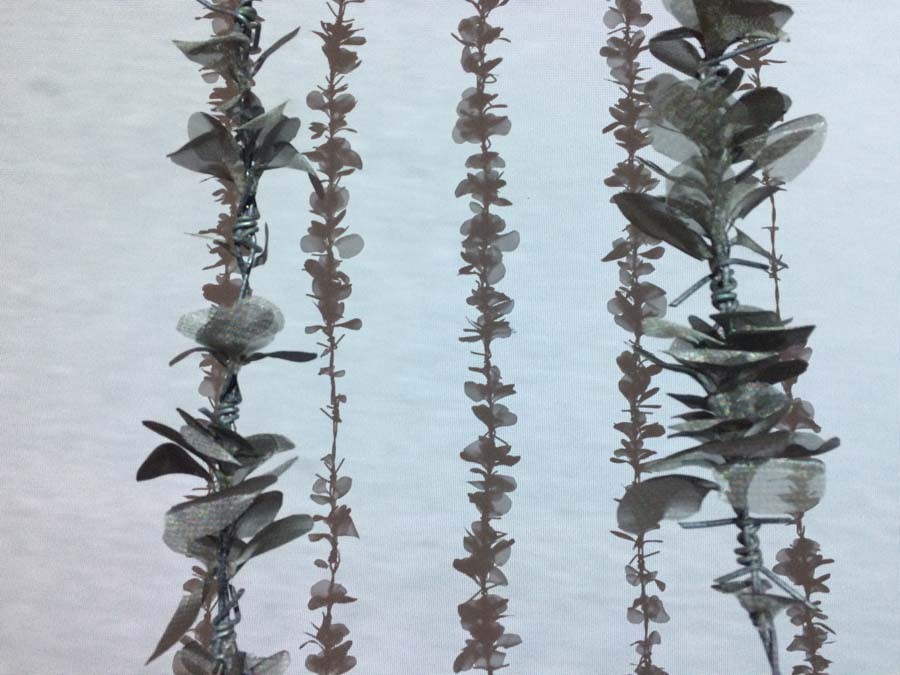
Facing Farida Batool’s art pieces at Rohtas 2, one recognises that our reality is not just one-dimensional; it is wide, varied and variable

Can there be a rose of steel? God created the flower with a delicate substance but humans tend to transform it into various versions: oil on canvas, watercolour on paper, photographic print, papier-mâché, plastic, fabric, thread and even wood. A rose is usually perceived to be a symbol of love and beauty. In our culture, rose petals are sprinkled on the coffin of a dead body and also on the grave, showing another form of love.
But can there be rose of steel? The unusual modification this love sign is witnessed at the solo exhibition of Farida Batool (‘Oos Roz Ki Adhoori Kahani..’) being held from Nov 10 to December 8, 2017 at Rohtas 2, Lahore. Here, in front of her single channel projection (Path was Grey), roses made in steel mesh and barbed wire are hung in five strings. This work titled The Roses were Red can be viewed separately but, in the exhibition, metal roses and the black & white video are combined to offer a composite and complete meaning.
A rose is not possible in a hard material; it is as paradoxical as a crystal hammer. Yet in our situation, it can be imagined and is relevant. It’s a society that survives on the brink or narrow line between life and death, love and loathing, pleasure and pain. Here, elders advise youngsters against laughing too much because it could bring sorrow and misery.
Recognising these streaks in our surroundings, Farida Batool is constructing works that deal with love and destruction. Her earlier Lenticular prints ‘Love Letter to Lahore’ and ‘Nai Reesaan Shehr Lahore Diyan’ (2006) suggested the presence of love and loss in our midst, since both works referred to the day when Lahore’s Mall Road and other streets were hit by a mob that showed its love for the Holy Prophet (pbuh). after hearing the news of blasphemous cartoons. The blend of strong sentiments of devotion for the Prophet and the desire to vanquish everything that represents Other (may that be West or Western) is evident in those works. Likewise, in another work ‘Oos Shehr Mein Mohabbat’ (2009), the barbed wires were composed in a way that these formed the shape of love symbol.
In the present work too one senses this dichotomy, with the roses fabricated in metal. But more than their placement against a video projection (2 minuet on loop), one reads and relates to the sense of desolation created with the overlapping of metal roses and documentation of a journey in which road is the only witness. A brilliant image maker, Batool blends the two through a simple device -- colour. Both metal roses and video projections offer multiple shades of grey; so these connect on another, formal, level. More than this, the work signifies an aspect of loss, since the strings of flowers and a plain stretch of land convey a feeling of disappearance, or the memory of someone, some place that has ceased to exist.
The aspect of loss is revisited in another work ‘The Screened Body’ (2 minutes single channel projection in loop on Perspex light box), in which a visitor looks at a ritual. A hand moves on parts of a body, yet both are not too obvious or directly discernible. Seeing the entire work, a viewer realises the existence of death and the custom of washing a dead body. The love, feeling and touch shown here capture the way a living person interacts with a deceased individual: father, mother, sister, brother, spouse, child, etc. How the departed being becomes a burden to be disposed soon. The strong sentiments and practical matters regarding the departed soul combine. Farida Batool translates that state by recording segments of a hand caressing or washing a body that cannot move. The fact that this projection is made on a Perspex light box adds into the content of the work; because in our long period of summer, the dead bodies are placed on or next to blocks of ice to prevent decomposition. In an interesting way, Batool constructs a light box which due to its colour, size and shade resembles an ice block. Thus, the image projected on its top and the structure both contribute towards comprehending the rituals of mortality.
Death or disappearance is dealt with in another work ‘Sunken Feet’ (Lenticular print, diptych). One identifies the traces of a human being through the mark of foot in one print and, in the next print, a spectator is submerged in a span of deep field strewn with fallen leaves. In both prints, one notices the uncanny feeling of space -- not possible within a two-dimensional piece on the wall -- but becomes believable due to the composition of parts. When you are in front of the work, you feel being exposed to a depth of field. The interplay of space is not just a formal achievement, it is a means to communicate the multiplicity and availability of a complex vision of reality, be it visual, conceptual, political or poetic.
While facing Farida Batool’s art pieces, one recognises that our reality is not just one-dimensional or modulated on single theme/viewpoint. It is wide, varied and variable. Sometimes contradictory too. But the pain to negotiate with that outside is visible in all three prints/video projections. One realises that the artist is changing her world into her work and her work into her world; a process that everyone who has experienced or fears the loss of their loved one can connect with.